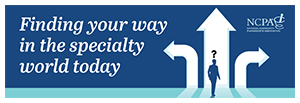Dear Colleague,
The stock market has been pounded this week but over the last five years, the S&P 500 is still up about 60 percent and the NASDAQ, about 83 percent. Now, I’m far from being an investor pro. For example, I bought $2,000 of Warner-Lambert stock as a 26-year-old, only to sell it a few months later for $2,500 thinking I had struck it rich with my $500 profit. Don’t even ask me about the opportunity for Chipotle shares when it split from McDonald’s in 2006. Experience and hindsight come in handy. Too bad I had neither to guide me through those transactions.
“Specialty” and biosimilar prescriptions now make up almost 55 percent of all the dollars spent on prescription drugs. The majority of those dollars are steered into “specialty pharmacies” owned by the big three consolidated PBM-insurers: Aetna-CVS, Cigna-Express Scripts, and United Health-Optum—to the tune of over $122.2 billion*. Because these three health plans and their PBMs are now business partners, they have even more market power to steer patients into their own mail order pharmacies and put a moat around them by offering below-cost reimbursement rates to their competition. Forgive my slight digression, but this seems like an excellent area for the FTC to look into as they do their PBM study. Despite the deck being stacked against all other competitors, there are still enough “crumbs” to make “specialty” and biosimilar prescriptions an area of interest for independent pharmacy owners.
 We know independently owned pharmacy teams have the best relationships to take care of the needs of patients being prescribed “specialty” or biosimilar medications. They just need to find their way in through the market gatekeepers. HIV, autoimmune disorders, and growth hormone are a few of the conditions treated by the top 10 “specialty” drugs. (Not exactly treating a cold.) Patients receiving a diagnosis for conditions requiring a “specialty” or biosimilar drug need the help of someone they trust and have a relationship with to help them navigate a complex health system that is stacked against them and can be shockingly cold at times. Local pharmacies can also help explain any important administration techniques, proper storage, and help by being the final mile in cold chain distribution—much more so than someone’s summer mailbox prescription redlining at 120 F.
We know independently owned pharmacy teams have the best relationships to take care of the needs of patients being prescribed “specialty” or biosimilar medications. They just need to find their way in through the market gatekeepers. HIV, autoimmune disorders, and growth hormone are a few of the conditions treated by the top 10 “specialty” drugs. (Not exactly treating a cold.) Patients receiving a diagnosis for conditions requiring a “specialty” or biosimilar drug need the help of someone they trust and have a relationship with to help them navigate a complex health system that is stacked against them and can be shockingly cold at times. Local pharmacies can also help explain any important administration techniques, proper storage, and help by being the final mile in cold chain distribution—much more so than someone’s summer mailbox prescription redlining at 120 F.
Some NCPA members have been successful with a targeted approach to a certain disease state. They work closely with local physicians and become the go-to experts for that disease state. Some are working with pharmaceutical manufacturers to capture the data they require and are being rewarded for that extra service.
The “specialty” marketplace has challenges that must be taken into consideration. Cash flow can be a problem while pharmacies wait to be paid by PBMs. A PBM audit can be devastating. (See my first digression above). There are limited distribution drugs. PBMs have restrictive networks. Despite the obstacles, it’s too big a market not to make a conscious decision whether to participate. BUT there are new options in the marketplace, such as taking a “specialty lite” business approach.
You can learn all about “specialty lite” from your peers and industry experts at the NCPA Annual Convention in Kansas City (hotel deadline is next Friday, Sept 9).
“Specialty” and biosimilars are going to take up more and more prescription dollars. Don’t wait for hindsight and experience to realize you got left behind.
Best,

B. Douglas Hoey, Pharmacist, MBA
NCPA CEO
